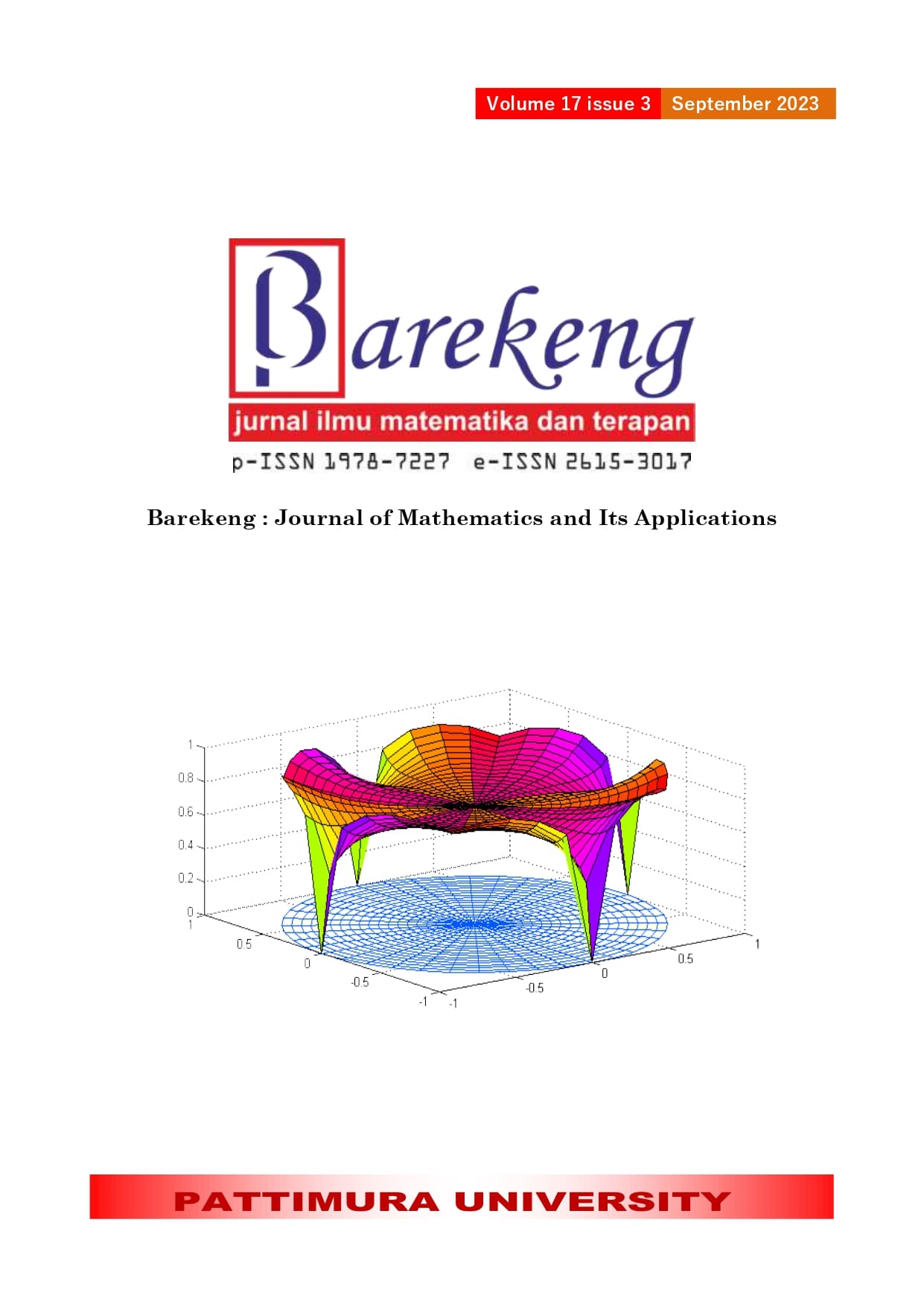COMPARISON OF FORECASTING RICE PRODUCTION IN MAGELANG CITY USING DOUBLE EXPONENTIAL SMOOTHING AND AUTOREGRESSIVE INTEGRATED MOVING AVERAGE (ARIMA)
Abstract
Magelang City has experienced a significant decline in the rice production sector, triggering the need for forecasting research as the next crucial step. This research aims to forecast rice production in Magelang city. By applying Double Exponential Smoothing and ARIMA methods, the most suitable forecasting model is identified. Data on rice production was obtained from the Badan Pusat Statistik (BPS) of Magelang city. The results revealed that the ARIMA (0,1,1) model with MSE of 479,259 was the best choice. This model is expressed as . Using this model, rice production was forecast from July to December 2023, the forecasting results showed that rice paddy production is expected to fluctuate in the coming months. For July 2023, production is projected to be around 65,1762 units, followed by 51,4779 units in August, 58,2432 units in September, and so on.
Downloads
References
I. R. Akolo, “Perbandingan Exponential Smoothing Holt-Winters Dan Arima Pada Peramalan Produksi Padi Di Provinsi Gorontalo,” J. Technopreneur, vol. 7, no. 1, pp. 20–26, 2019, doi: 10.30869/jtech.v7i1.314.
F. A. Chyon, M. N. H. Suman, M. R. I. Fahim, and M. S. Ahmmed, “Time series analysis and predicting COVID-19 affected patients by ARIMA model using machine learning,” J. Virol. Methods, vol. 301, no. December 2021, p. 114433, 2022, doi: 10.1016/j.jviromet.2021.114433.
G. Moiseev, “Forecasting oil tanker shipping market in crisis periods: Exponential smoothing model application,” Asian J. Shipp. Logist., vol. 37, no. 3, pp. 239–244, 2021, doi: 10.1016/j.ajsl.2021.06.002.
L. Zhao, Z. Li, and L. Qu, “Forecasting of Beijing PM2.5 with a hybrid ARIMA model based on integrated AIC and improved GS fixed-order methods and seasonal decomposition,” Heliyon, vol. 8, no. 12, p. e12239, 2022, doi: 10.1016/j.heliyon.2022.e12239.
S. G. Wawale, A. Bisht, S. Vyas, C. Narawish, and S. Ray, “An overview: Modeling and forecasting of time series data using different techniques in reference to human stress,” Neurosci. Informatics, vol. 2, no. 3, p. 100052, 2022, doi: 10.1016/j.neuri.2022.100052.
N. Salwa, N. Tatsara, R. Amalia, and A. F. Zohra, “Peramalan Harga Bitcoin Menggunakan Metode ARIMA (Autoregressive Integrated Moving Average),” J. Data Anal., vol. 1, no. 1, pp. 21–31, 2018, doi: 10.24815/jda.v1i1.11874.
H. Erkekoglu, A. P. M. Garang, and A. S. Deng, “Comparative Evaluation of Forecast Accuracies for Arima, Exponential Smoothing and Var,” Int. J. Econ. Financ. Issues, vol. 10, no. 6, pp. 206–216, 2020, doi: 10.32479/ijefi.9020.
Nugroho Arif Sudibyo, Ardymulya Iswardani, Arif Wicaksono Septyanto, and Tyan Ganang Wicaksono, “Prediksi Inflasi Di Indonesia Menggunakan Metode Moving Average, Single Exponential Smoothing Dan Double Exponential Smoothing,” J. Lebesgue J. Ilm. Pendidik. Mat. Mat. dan Stat., vol. 1, no. 2, pp. 123–129, 2020, doi: 10.46306/lb.v1i2.25.
C. B. Aditya Satrio, W. Darmawan, B. U. Nadia, and N. Hanafiah, “Time series analysis and forecasting of coronavirus disease in Indonesia using ARIMA model and PROPHET,” Procedia Comput. Sci., vol. 179, no. 2020, pp. 524–532, 2021, doi: 10.1016/j.procs.2021.01.036.
P. G. Gould, A. B. Koehler, J. K. Ord, R. D. Snyder, R. J. Hyndman, and F. Vahid-Araghi, “Forecasting time series with multiple seasonal patterns,” Eur. J. Oper. Res., vol. 191, no. 1, pp. 207–222, 2008, doi: 10.1016/j.ejor.2007.08.024.
M. Fayaz, G. Meraj, S. A. Khader, and M. Farooq, “ARIMA and SPSS statistics based assessment of landslide occurrence in western Himalayas,” Environ. Challenges, vol. 9, no. May, 2022, doi: 10.1016/j.envc.2022.100624.
S. I. Busari and T. K. Samson, “Modelling and forecasting new cases of Covid-19 in Nigeria: Comparison of regression, ARIMA and machine learning models,” Sci. African, vol. 18, p. e01404, 2022, doi: 10.1016/j.sciaf.2022.e01404.
I. Khandelwal, R. Adhikari, and G. Verma, “Time series forecasting using hybrid arima and ann models based on DWT Decomposition,” Procedia Comput. Sci., vol. 48, no. C, pp. 173–179, 2015, doi: 10.1016/j.procs.2015.04.167.
H. Alabdulrazzaq, M. N. Alenezi, Y. Rawajfih, B. A. Alghannam, A. A. Al-Hassan, and F. S. Al-Anzi, “On the accuracy of ARIMA based prediction of COVID-19 spread,” Results Phys., vol. 27, p. 104509, 2021, doi: 10.1016/j.rinp.2021.104509.
A. M. Khan and M. Osińska, “Comparing forecasting accuracy of selected grey and time series models based on energy consumption in Brazil and India,” Expert Syst. Appl., vol. 212, no. August 2022, 2023, doi: 10.1016/j.eswa.2022.118840.
K. E. ArunKumar, D. V. Kalaga, C. M. Sai Kumar, G. Chilkoor, M. Kawaji, and T. M. Brenza, “Forecasting the dynamics of cumulative COVID-19 cases (confirmed, recovered and deaths) for top-16 countries using statistical machine learning models: Auto-Regressive Integrated Moving Average (ARIMA) and Seasonal Auto-Regressive Integrated Moving Average (SARIMA),” Appl. Soft Comput., vol. 103, no. December 2019, p. 107161, 2021, doi: 10.1016/j.asoc.2021.107161.
E. M. de Oliveira and F. L. Cyrino Oliveira, “Forecasting mid-long term electric energy consumption through bagging ARIMA and exponential smoothing methods,” Energy, vol. 144, pp. 776–788, 2018, doi: 10.1016/j.energy.2017.12.049.
Copyright (c) 2023 M. Imron, Hani Khaulasari, Diva Ayu SNM, Jauharotul Inayah, Eka Eliyana S

This work is licensed under a Creative Commons Attribution-ShareAlike 4.0 International License.
Authors who publish with this Journal agree to the following terms:
- Author retain copyright and grant the journal right of first publication with the work simultaneously licensed under a creative commons attribution license that allow others to share the work within an acknowledgement of the work’s authorship and initial publication of this journal.
- Authors are able to enter into separate, additional contractual arrangement for the non-exclusive distribution of the journal’s published version of the work (e.g. acknowledgement of its initial publication in this journal).
- Authors are permitted and encouraged to post their work online (e.g. in institutional repositories or on their websites) prior to and during the submission process, as it can lead to productive exchanges, as well as earlier and greater citation of published works.






1.gif)



